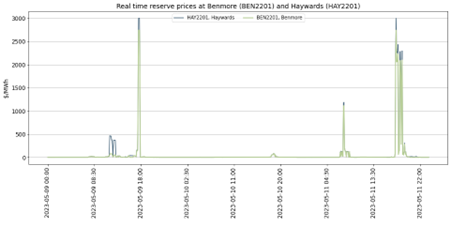Eye on electricity
First instances of reserve scarcity pricing under real-time pricing
- Retail
- Prices
The Electricity Authority implemented real-time pricing for the wholesale electricity market in November 2022 in collaboration with Transpower and the wider electricity industry. This changed how and when the electricity spot price is calculated. Generators now receive and retailers now pay a spot price based on real-time supply and demand conditions.
Previously, the final spot price was not confirmed until at least two days later. It was based on the marginal cost of supply to meet average demand during each half-hour trading period, given grid conditions (such as transmission constraints) at the start of the trading period. However, to react to evolving conditions generators can be dispatched every 5 minutes within a trading period. So changing supply and demand conditions during the half hour (such as a sudden decrease in wind), were not captured in the final price for that half hour.
The final spot price is now calculated using 5-minute prices (or thereabouts – the exact time can differ) that change during each half-hour trading period. The final spot price is published at the end of the trading period. Now when changes occur during a trading period, electricity generators and consumers can see these changes reflected in the final spot price. These actionable price signals are an important part of encouraging more demand response.
Demand response is a key component to achieve an efficient and highly renewable electricity system. It enables consumers to react in real time to increasing electricity spot prices, and they can decide to consume less if prices are higher. With more intermittent generation (ie, generators where the output cannot be guaranteed, such as wind and solar that rely on the weather) being built, demand response, at times of low wind and/or solar generation, will be necessary to keep overall system costs down and reduce emissions.
While most consumers are currently either hedged or on fixed price contracts (meaning they are insulated from changes in the spot price), some large industrial companies may face some exposure to spot prices so may want to consume less when spot prices are higher. Residential consumers can now sign up for products such as that offered by some retailers, where they can save money by enabling flexible energy use and help reduce emissions.
As part of real-time pricing, reserve and energy scarcity prices were introduced. In any half-hour trading period, if demand increases or wind falls, the electricity supply needed to meet demand can become scarce, causing spot prices to rise. Most of the time, spot prices generally signal the state of supply relative to demand in this way. However, on rare occasions generation can become so scarce that there is not enough generation available to hold in reserve.1 Reserve is needed to cover the loss of the largest part of the system that could fail (called “reserve scarcity”). It is very rare that generation may become so scarce that there is not enough to cover demand and forced power cuts are required (called “energy scarcity”).
Under real-time pricing, if there is reserve or energy scarcity, scarcity pricing will automatically be applied. Spot prices will now reflect the type and severity of an energy or reserve shortfall. This also provides real-time information that consumers need if they want to manage their demand or use distributed energy resources which provide extra resources to the market. In the past, final prices during reserve scarcity were particularly uncertain as there were no such reserve scarcity prices applied at the time parties were needing to make decisions.2
On Tuesday 9 May 2023, the first instance of reserve scarcity pricing occurred. For about 13 minutes, the system did not have enough reserves to cover the loss of the largest risk on the system. Reserve prices went up to the reserve scarcity price of $3,000/MWh. These reserve prices were reflected in the final spot price of electricity. See figure 1 below.
Then a second instance of reserve scarcity happened two days later, on 11 May 2023, and a third instance on 16 May 2023. The system operator had sent out a notice of a low residual situation for the 11 May 20233, so it was forecast to be a tight period of electricity supply.
These instances of reserve scarcity pricing are examples of real-time pricing functioning as designed. They signal to the industry what was happening (ie, reserve scarcity) in real time, and allow participants to react.

1.Keeping the lights on with reserves
2. Only some dummy values could be seen in real time (called infeasibility prices), which did not flow through to the final price.
3. These are instances where there is forecast to be 200 MW or less excess generation available in the system after covering forecast demand for energy and reserves. These are signals to the industry to increase the amount of generation and reserve on offer.
Related News
Information session for retailers on new mandatory reporting under the Retail Market Monitoring notice
We invite retailers to our information session where we will answer your questions ahead of the first report which is due on 31 August 2025.
Highlighting retailers’ obligations to protect medically dependent consumers
Under the Consumer Care Obligations retailers must not disconnect registered medically-dependent consumers, and must notify the Authority as soon as they becom…
An explanation of ASX forward prices
In 2022 we published an article that looked into how the ASX forward electricity market works and the factors that affect these prices. This article looks at s…